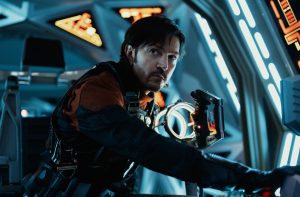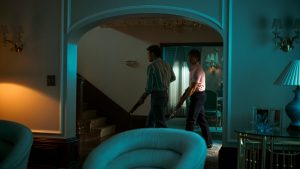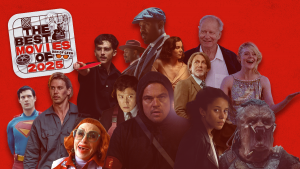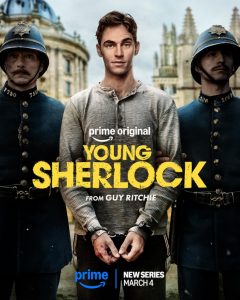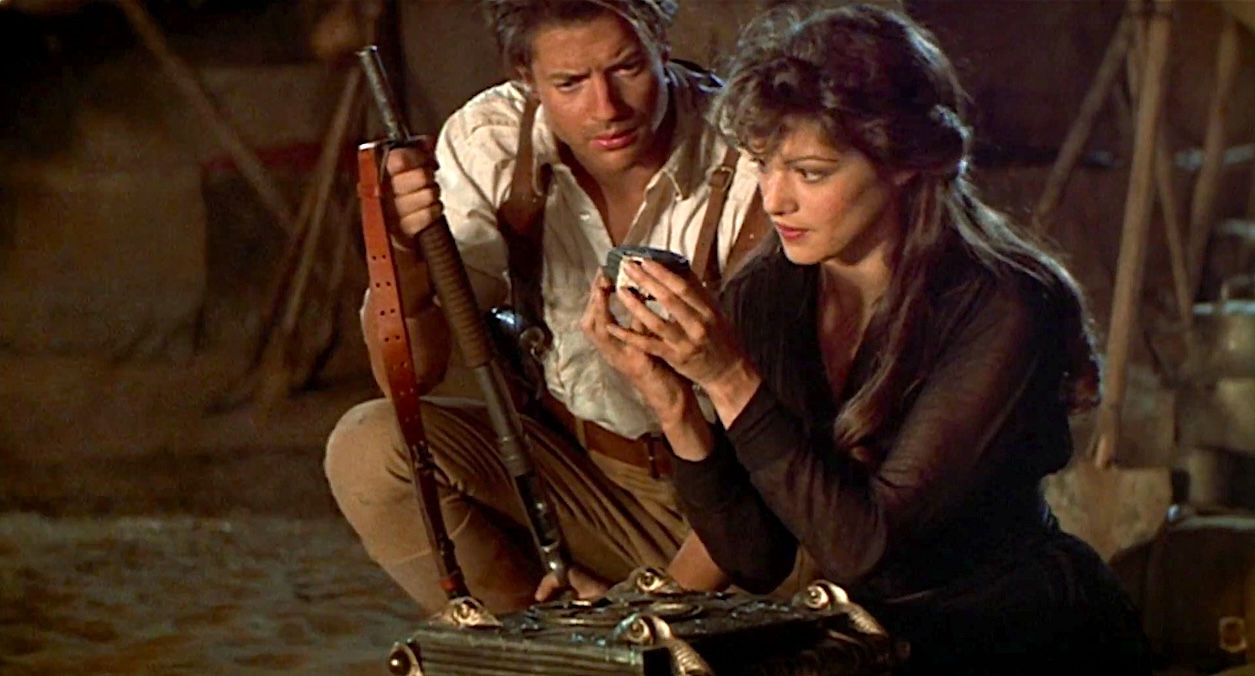
The desert may grow cold at night, but for two intrepid adventurers and would-be fortune seekers, the evening is flush with excitement. Earlier in the day these heroes—rugged Rick O’Connell (Brendan Fraser) and effervescent Evelyn Carnahan (Rachel Weisz)—seemed to make a breakthrough on their grave-robbing exploits after they literally broke through the ceiling of a tomb, discovering a juicy mummy along the way. A little later, they got in a shootout with desert nomads and bedouin, which nonchalantly left a body count well into the double digits. And yet, none of that really seemed to matter in the grand scheme of things, either to the characters or the audience watching them. Nay, the most thrilling thing about this portion of Stephen Sommers’ The Mummy is just how buzzed they, and by extension we, are getting from the shared company… plus the bottle of 15-year-old Scotch they just swiped off a corpse.
In a scene that would have merely served as perfunctory exposition and banal characterization in any other blockbuster, Rick and Evie’s fireside chat genuinely charms and ingratiates. The pair is clearly smitten while dancing around, as Evie surmises, “What is a place like me doing in a girl like this?” Or something like that. Eventually, she is able to give a resolute answer: “I may not be an explorer or an adventurer, or a treasure-seeker, or a gunfighter, Mr. O’Connell!” Weisz boasts as she keeps rising in her posture and volume. “But I am proud of what I am… I am a librarian!”
To this day, I know folks who’ve worked in libraries who proudly claim Evie as one of their own. Modern blockbusters and franchise films should be so lucky to do the same. Because despite appearing in a late ‘90s special effects-driven summer movie, Rick and Evie have managed to walk off with multiple generations’ worth of goodwill thanks to two beguiling performances and a director who knew how to use them.
True star quality is something that can never be wholly quantified or mass-produced, no matter how confident suits become in their algorithms and “shared universes.” But when it shines, it dazzles like the desert sun. Such is the case of Fraser and Weisz in The Mummy, two actors who became marquee names because Rick and Evie knew how to sizzle and swoon in poses that would not have looked out of place on the cover of romantic dime novels from a hundred years ago. And a quarter-century after The Mummy’s release, the truth is we still all secretly would like to be reading from that sort of collection.
The Librarian and the Gunfighter
When revisiting The Mummy for its 25th anniversary, one can be surprised by how flirtatious everything is, both in terms of its characters and the way the movie treats them. While it’s never gone out of vogue for Hollywood studios to cast conventionally attractive leads (and there are few more attractive than Fraser and Weisz), at some point in the last 25 years, executives became convinced that in spite of insisting on obligatory love stories meant to appeal to every last demographic, those romances needed to also be as anodyne as an IRS tax return.
The Marvel Cinematic Universe, which has been the gold standard for box office success in the last 15 years, almost always crowbars in love interests for its heroes, yet we dare you to name Hawkeye’s wife or who the supremely talented Rachel McAdams was asked to play in Doctor Strange without the use of Google. James Cameron had the right of it when he said a few years ago that movie superheroes generally behave “like they’re in college.” One might even suggest they’re arrested at a half-dozen years before that. Which is perhaps one of the key reasons The Mummy remains so timeless today.
Admittedly, Sommers’ adventure flick wasn’t exactly reinventing the wheel when it was released in May 1999. The general setup of Rick and Evie is intentionally as antiquated as those black and white serials that inspired George Lucas to invent Indiana Jones—and which in turn inspired Sommers’ The Mummy. While the titular undead fiend played by Arnold Vosloo never quite resorts to tying Evie to railroad tracks, his dabbling in ritualistic sacrifice comes on with about the same frequency as the 3:10 afternoon train.
Yet it’s in the details, then, where The Mummy’s golden reputation still shimmers, beginning with the fact that both Rick and Evie have the floorspace to happily and unapologetically be what she initially sizes them up as: the librarian and the gunfighter.
When we meet Evie in the film, she is neither helpless nor obligatory. In fact, she’s performing a sight gag that would do Charlie Chaplin proud. Weisz is introduced as hovering, ever so precariously, on an elephant ladder between two bookcases. The subsequent crash makes for a spectacular sight gag. The scene is obviously played for laughs, but it establishes a truth that Weisz plays earnestly thereafter: Evie is not an action heroine or brawler who will be contextualized onscreen with the kind of visual shorthand that was common in ‘90s and early 2000s action movies, which often could be reduced to “she’s the cool girl” because she acts just like the guys—or the modern descendent of that trope in which the personalities of the heroes, whether they be men or women, are entirely mooted to the point where they’re all interchangeable.
Evie is a genuine scholar and nerd, by contrast. Wonderfully so. Nearly every line Weisz has piques O’Connell and the audience’s interest in Egyptology through sheer enthusiasm and charisma.
Meanwhile, for all his swashbuckling swagger, Fraser’s Rick could never be mistaken as Errol Flynn. To be sure, he gets a couple of dashing introductions, first as a French Foreign Legion officer who bravely leads men into a doomed, but somehow still lighthearted, battle; and then a few scenes later, Fraser’s Rick is re-discovered by Evie behind the bars of a North African prison, greasy and disheveled. This time round, he could very well double as an illustration out of an Edward Rice Burroughs paperback.
Visually Rick is a character constantly risking cliché, and yet never falls into it thanks to Fraser’s wry, and constant, self-awareness. Even by this early point in his career, the actor had mostly shaped his onscreen persona which would breakout in The Mummy, and it’s a delicate balance he walks. Not once can Fraser be fully accused of smirking at the camera, as if to wink “can you believe this nonsense they’re having me say?,” a phenomenon that bedevils many modern studio tentpoles. However, he still applies such a naturally gregarious good humor to Rick that he’s blatantly inviting you to laugh along at the ludicrous scenarios—such as stealing a kiss between bars mere seconds before execution.
Weisz plays her role sincere while Fraser’s turn is bemused. But it is the combined blending of those energies that gives their chemistry its riveting insatiability. Sommers designed The Mummy to be a throwback to old school adventure yarns, but what made it really timeless wasn’t the turn-of-the-century CG effects. It’s Fraser and Weisz’s ability to seduce one another, and us.
Together these characters are equals without being identical in personality or talent. In Sommers’ original Mummy, Evie is never going to decapitate a monster, and Rick is never going to be able to figure out how to read a hieroglyph and utilize ancient sorcery. The movie allows each of its heroes to have complementary strengths instead of redundant similarities. It heightens their individuality as well as the film’s strong reliance on an “opposites attract” energy. In one simplistic reading, the movie could even be mistaken as a story of the hero and his best gal; in another though, it is that of an ahead-of-her-time Egyptologist and her himbo bodyguard she must put up with to prove herself in the Sahara.
Sommers uses an old-fashioned (and some might say antiquated) storytelling template to build a winsome romance that keeps the proceedings eternally at a light, frothy simmer.
A Love Story That Kept Kicking
The wild success of The Mummy took Universal Pictures by surprise. While the studio agreed to invest more than it initially wanted into Sommers’ vision for a period piece adventure epic, Universal did not expect the movie to gross $156 million in the U.S. alone (about $286 million today). Back then that was considered a massive haul for an original(ish) summer movie. So a sequel was immediately greenlit.
Arriving a scant two years later, The Mummy Returns is hardly the classic that the original film became. However, it has its qualities, and chief among them remains Fraser and Weisz’s ability to smolder as Rick and Evie. And as became the custom for family-skewing franchises in the early 2000s after The Phantom Menace, The Mummy Returns also introduced a precocious child (Freddie Boath) to join in the escapades, making Rick and Evie a literal family unit.
Even so, Sommers never lost sight of the allure of his leads’ chemistry. In fact, he avoided the trapping of many other contemporary sequels that went similar routes, such as the disastrous sequel to 1998’s hugely entertaining The Mask of Zorro. Despite that first movie being a superb crowdpleaser in large part because of the smolder between Antonio Banderas and Catherine Zeta-Jones (the latter in a star-making role), the belated 2000s sequel, The Legend of Zorro, not only gave them their own precocious child sidekick, but decided to almost immediately divorce the parents and set them against each in an antagonistic relationship for the rest of the movie. It was ostensibly intended to replicate the sizzle of the first film’s will-they-or-won’t-they-get-together; instead the movie curdled it.
This is the same mistake made by many similar sequels of this era (see: the Pirates of the Caribbean trilogy and National Treasure: Book of Secrets). However, for whatever other faults The Mummy Returns suffers, it never forgets that audiences were won over by its stars’ chemistry in the first place. And never once are Rick and Evie pitted against each other in a strained attempt to generate conflict, nor are their scenes rushed through in order to get to one of the pricy action sequences (which is, ahem, where The Mummy Returns actually runs into trouble).
Rather the film doubles down on the sexiness and banter of its now married leads, pausing for multiple sequences of Evie prodding old war buddies about Rick’s bachelor days, or a scene of what could be dry exposition turned into giddy fooling around as Evie recounts the legend of the Scorpion King by falling into her hubby’s arms.
In at least this sense, The Mummy Returns has aged far better than many of its franchised contemporaries and works best at the end when the film reveals itself to be a contrast in love stories between that of Rick and Evie, and that of the undead Imhotep (Vosloo) and Anck-Su-Namun (Patricia Velásquez)—something that plays a lot better than anything involving Dwayne Johnson’s face being digitally rendered by what appears to be PlayStation 2 technology.
Of course Rick and Evie are not the only core ingredients in the spell Sommers was able to conjure with that first Mummy. Actual on-location filming in North Africa (Morocco doubling for Egypt) grounds the action a way that is still endearing, no matter how ancient the CG effects around those real sand dunes become; the larger supporting cast including Vosloo, John Hannah, Oded Fehr, and Velásquez constitute nothing less than a charm offensive which that still leaves social media breathlessly insisting that the movies marked the great bisexual awakening of the millennial generation. Also, frankly my dear, the movie remains the best Indiana Jones flick made after 1989.
In a story preoccupied with the Book of the Dead and spells of resurrection, it is Fraser and Weisz’s harmonizing performances that continue to give this film life long after its time in the sun was meant to expire.
The post The Mummy: Modern Movies Would Kill for Chemistry Like Rick and Evie appeared first on Den of Geek.
